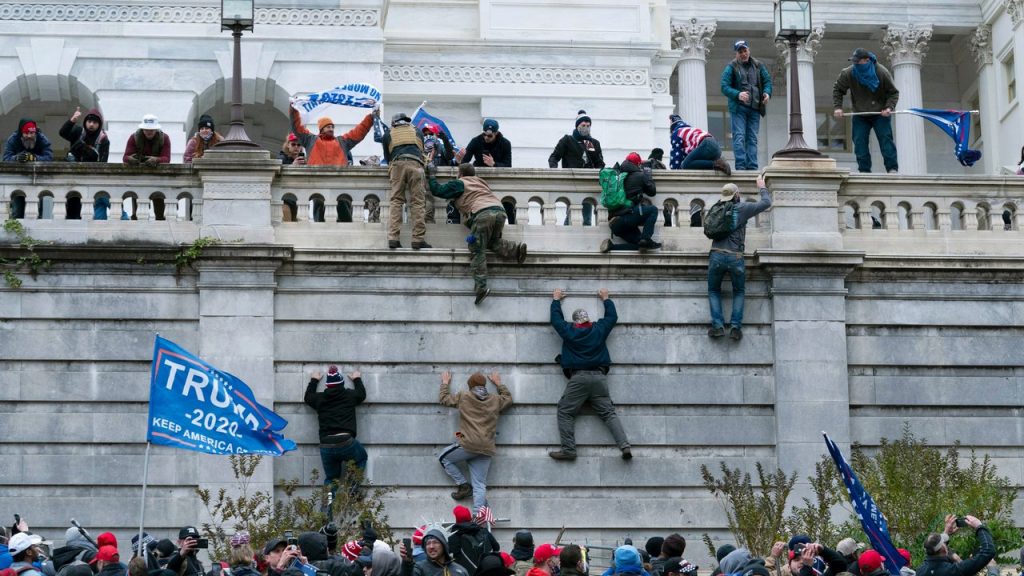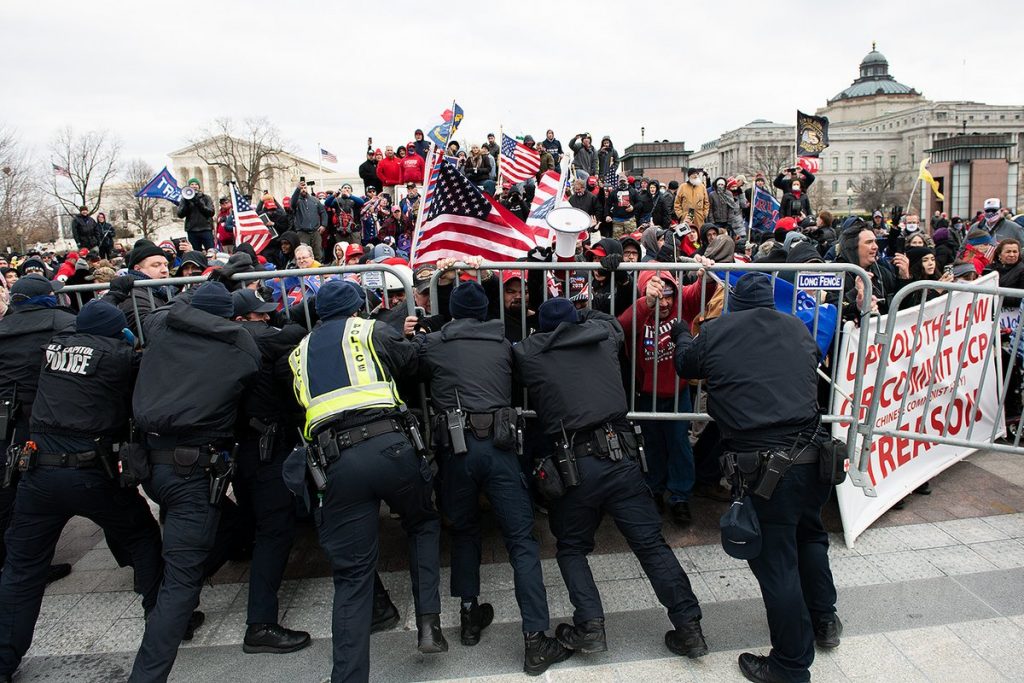The report found the Capitol Police command system broke down during the riot. One officer said a lieutenant asked via radio, “does anybody have a plan?”
U.S. Capitol Police leaders learned that Trump supporters were discussing ways to infiltrate tunnels around the complex and target Democratic members of Congress on Jan. 6 but failed to act on the threats, according to a new Senate report summing up what it says were profound intelligence and security failures that contributed to one of the worst incidents of domestic terrorism in U.S. history.
The report also says that officers complained about a lack of leadership within the department as they tried to repel the attack — and those top leaders were virtually silent as they begged for help.
Through tips from the public and other sources, Capitol Police “knew about social media posts calling for violence at the Capitol on January 6, including a plot to breach the Capitol, the online sharing of maps of the Capitol Complex’s tunnel systems, and other specific threats of violence,” the report said, but the police force’s intelligence division “did not convey the full scope of known information to USCP leadership, rank-and-file officers, or law enforcement partners.”
The Capitol Police’s possession of the specific intelligence had been previously flagged by the department’s inspector general in a report that has not made public, NBC News and other news organizations have reported. But the Senate document sheds new light on it. The failure to distribute the information widely, the report says, left rank-and-file Capitol Police officers unprepared to defend themselves from the armed mob.
“The objects thrown at us varied in size, shape, and consistency,” an officer said. “Some were frozen cans and bottles, rebar from the construction, bricks, liquids, pepper spray, bear spray, sticks of various widths, pipes, bats.”
Another officer told Senate investigators: “We were ill-prepared. We were NOT informed with intelligence. We were betrayed.”
The 100-page Senate report, the results so far of a joint investigation by the Homeland Security and Rules committees, offers new details about what Capitol Police leaders knew and when they knew it. It recommends an overhaul of what it calls the “opaque” structure of the board overseeing the Capitol’s security apparatus, with a specific provision to allow the Capitol Police chief to request National Guard assistance immediately after it found that Washington, D.C., National Guardsmen didn’t arrive at the Capitol for nearly three hours after they were first requested.
But the report mostly reprises a timeline that has already been made public, and it leaves many questions unanswered. In that sense, it is likely to be viewed as no substitute for the kind of 9/11-style independent commission, with full subpoena power, that failed to pass Congress last month over Republican opposition.
The report does not layout, for example, what, if any, threat information the FBI had about a possible attack on the Capitol or possible violence by extremist groups whose members were under FBI investigation.

Neither the Justice Department nor the Department of Homeland Security fully complied with information requests by the committees, the report says, limiting the Senate’s insights into the internal deliberations around the agencies’ intelligence collection and dissemination.
The report also criticizes the actions of the FBI and DHS, noting that neither published an intelligence bulletin before the Jan. 6 counting of the Electoral College votes despite widespread public indications of significant and possible violent protests planned in Washington. Both agencies have defended their actions.
“A key contributing factor to the tragic events of January 6 was the failure of the Intelligence Community to properly analyze, assess, and disseminate information to law enforcement regarding the potential for violence and the known threats to the Capitol and the Members present that day,” the report says. “Further scrutiny of these failures and the preparations and response of federal agencies will continue.”
Top officials from the FBI and DHS testified in public hearings this year that they were aware of threats on social media from people who talked about perpetrating violence on Jan. 6 to stop what they viewed as the certification of a fraudulent election, but they said they did not deem the threats credible enough to describe them as intelligence.
The day before the riot, the FBI’s field office in Norfolk, Virginia, passed along a report about online discussions of violence directed at Congress, including indications that protesters were heading to Congress “prepared for war.” But the FBI’s top counterterrorism official told Congress that the report was deemed “information off the Internet, unattributable to a specific person.” Within the Capitol Police, it was not circulated to leaders, the report says.
The Senate report focuses particular scrutiny on the current acting Capitol Police chief, Yogananda Pittman, who was a deputy in charge of the force’s three intelligence components in the months leading up to the riot. Pittman was named acting chief after Stephen Sund, who was chief during the riot, was forced to resign.
Pittman, the report notes, contradicted herself on the question of whether Capitol Police knew or should have known that protesters might try to breach the Capitol on Jan. 6.
On Jan. 26, she told lawmakers, “We knew that there was a strong potential for violence and that Congress was the target.” But on Feb. 25, she disputed that there had been any “specific, credible threat that thousands of protestors would descend on the Capitol with the intent to disrupt the Electoral College vote certification,” the report said.
“The variations in Ms. Pittman’s testimony reflect the lack of consensus about whether the available intelligence information contained specific threats,” the report says.
Pittman did not respond to a request for comment made through the Capitol Police.
In a statement, Capitol Police said the department welcomed the report and was committed to improving its operations. But, the statement added, “neither the USCP, nor the FBI, U.S. Secret Service, Metropolitan Police or our other law enforcement partners knew thousands of rioters were planning to attack the U.S. Capitol. The known intelligence simply didn’t support that conclusion.”

‘Does anybody have a plan?’
Many of the details laid out in the report have previously been made public. The report reprises some of the failures that were exposed during several public hearings by the investigating committees, including the muddled response at the Pentagon that led to a three-hour delay in the arrival of D.C. National Guard.
The committee did not find evidence that then-President Donald Trump personally intervened to delay the response, a committee aide said. The report says the Pentagon’s slow response was “informed by criticism” of its previous and much-criticized involvement in quelling protests last summer related to the murder of George Floyd.
The report does not make a finding in the dispute about whether anyone in the military resisted sending the National Guard because of “optics,” as acting Washington Police Chief Robert Contee testified — an assertion military officers denied.
Investigators also criticized the Capitol Police response, noting a previously reported finding that rank-and-file officers were not provided with basic protective equipment or periodic training in basic civil disturbance tactics.
Also previously known as the report’s finding that the Capitol Police incident command system broke down during the attack, leaving front-line officers without key information or instructions as events unfolded.
But the report includes new, harrowing accounts from line officers whom it does not name.
“There was a very little direction, if any, provided by ranking members of the USCP throughout the whole day — mid-level and senior leadership were providing very little, if any, direction,” an officer said. “I felt like I was alone and I felt like I had to make my own decisions.”
Another officer said: “I was horrified that NO deputy chief or above was on the radio or helping us. For hours the screams on the radio were horrific the sights were unimaginable and there was a complete loss of control. … For hours NO Chief or above took command and control. Officers were begging and pleading for help for medical triage.”
Officers did not recall having heard Sund on the radio at any point during the attack, and they recalled having heard Pittman only once — when she ordered a lockdown of the Capitol at 2 p.m. Neither explained to investigators why leaders did not directly communicate with officers.
An officer reported hearing a lieutenant repeatedly ask over the radio, “does anybody have a plan?”
The Senate report was most detailed in examining the information flow and decision-making at the Capitol Police, in part because the committees were able to obtain email and other relevant documents.
The day before the riot, the FBI informed Capitol Police about posts on a website called thedonald.win, on which Trump supporters had been exchanging information about tunnels around the Capitol and “stating their goal of finding Democratic Members early to block them from entering the Capitol.”
The email also noted a “huge uptick with reporting via open-source of the groups’ intentions of forming a perimeter around the campus,” the Senate report says.
NBC News reported in April that thedonald.win featured hundreds of social media posts discussing plans to move on the Capitol, including a map of the building and talk about how to create a stampede that would overwhelm Capitol Police.
“You know there will be riot police preventing us from getting in the capitol building,” an anonymous poster wrote in December. “What if we created a stampede/crush situation? Start pushing from the back. Surely they will have to get out of the way or get crushed. They’re not going to start shooting people.”
At the time, the FBI was saying it had no credible information that anyone planned to attack the Capitol.
The report found that Capitol Police did nothing with the warning.
“The warnings regarding the tunnel system were not elevated to leadership,” the report said, adding that the department’s inspector general concluded this year that “there is no clear channel for the distribution of intelligence information up to the Chief and down to the line officers and across departmental entities.”
In fact, Capitol Police officers told the committees that they received no warning about the possibility of violent protests on Jan. 6, the report says.
The Capitol Police Labor Committee told investigators that Capitol Police leaders “failed to share key intelligence with officers in advance, they failed to prepare adequately, they failed to equip our officers with a plan, and on that very day, they failed to lead.”
 Alghadeer TV Alghadeer TV
Alghadeer TV Alghadeer TV
